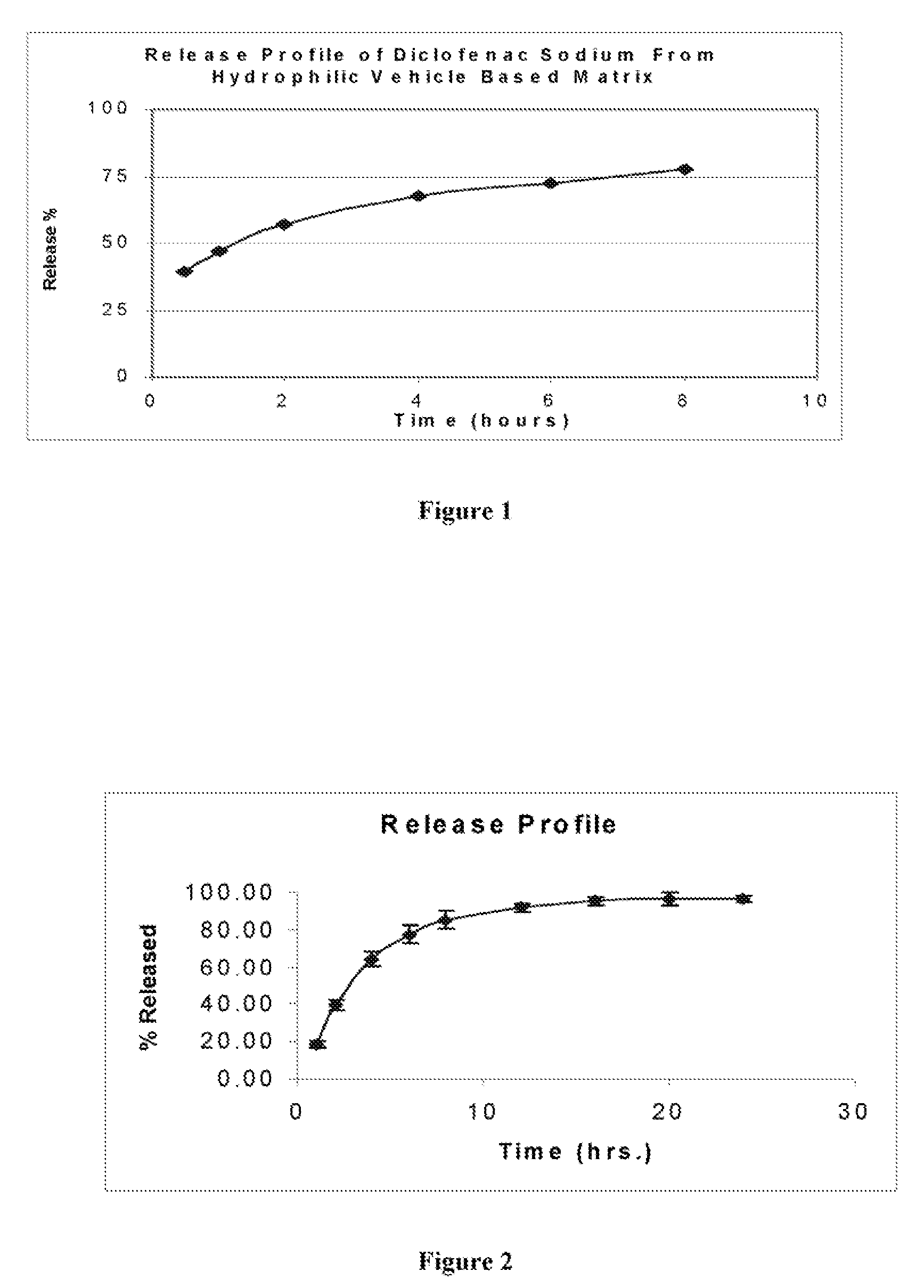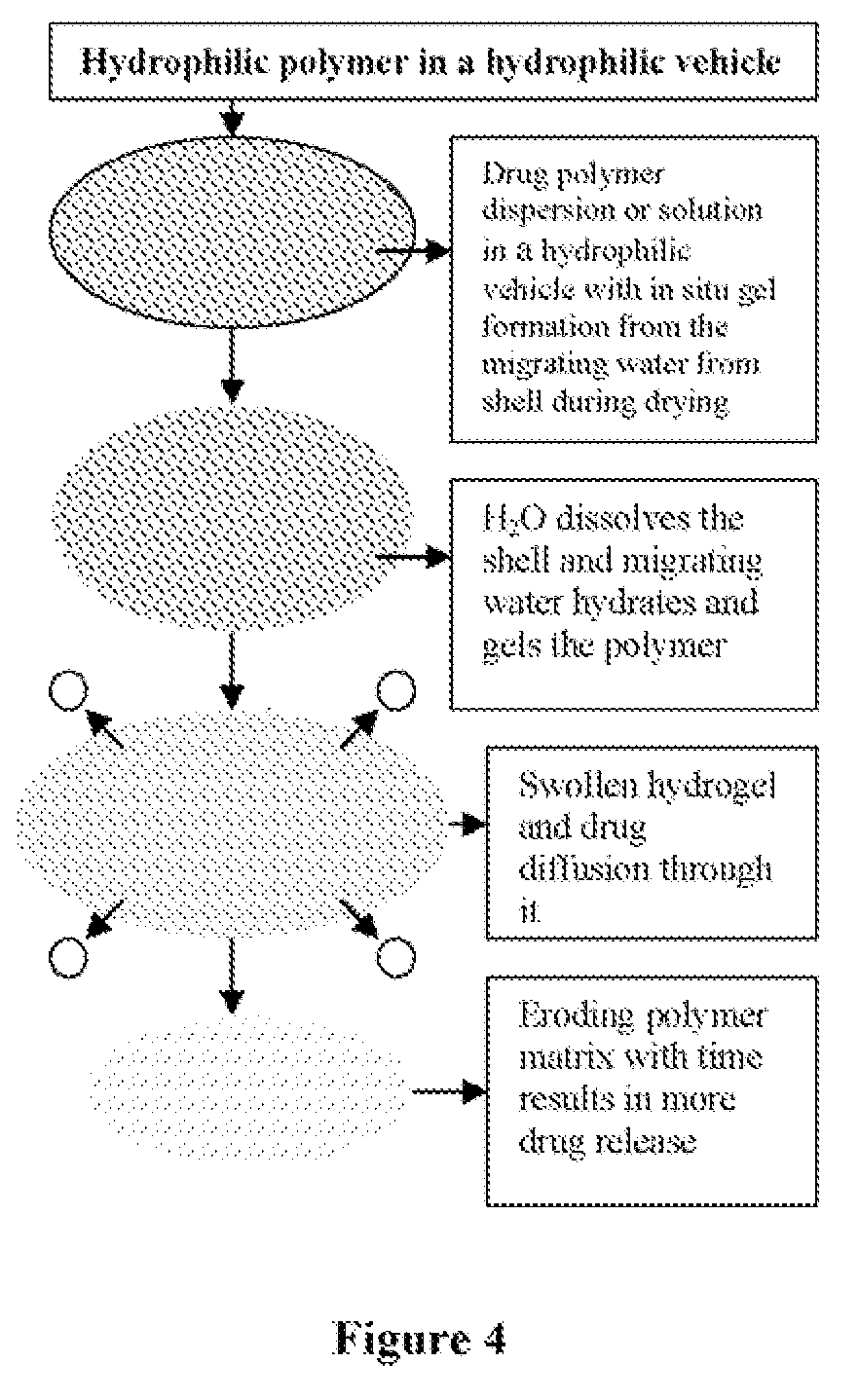Hydrophilic vehicle-based dual controlled release matrix system
a matrix system and hydrophilic technology, applied in the direction of pharmaceutical active ingredients, capsule delivery, medical preparations, etc., can solve the problems of difficult extraction of drugs from dosage forms, and achieve the effects of reducing or preventing drug misuse, reducing the need for organic solvents, and reducing the need for low-dose compounds
- Summary
- Abstract
- Description
- Claims
- Application Information
AI Technical Summary
Benefits of technology
Problems solved by technology
Method used
Image
Examples
example 1
Preparation of a Diclofenac Sodium Fill Matrix
[0051]A hydrophilic vehicle-based dual controlled-release matrix system was prepared containing the following ingredients.
[0052]
% wt. of fillName of the ingredientmatrixPolyethylene glycol60CARBOPOL ®2.5Hypromellose10PVP K902.5Diclofenac sodium25
[0053]CARBOPOL® and PVP K90 were dispersed in liquefied / melted polyethylene glycol just above its congealing temperature while mixing with a suitable mixer. Hypromellose was added to the mixture with stirring. Diclofenac sodium was then added to the mixture with continuous stirring. The blend was homogenized and deaerated prior to encapsulation in soft gelatin capsules. The same procedure was used to prepare the diltiazem and ibuprofen fill matrix preparations.
[0054]In vitro drug release studies were conducted using a USP dissolution apparatus II (paddles) at 50 rpm. The results are shown in FIG. 1. Experiments were conducted in dissolution media at a temperature of 37.0±0.5° C. for 8 hours in 6....
example 2
Preparation of a Diltiazem Hydrochloride Fill Matrix
[0055]A hydrophilic vehicle-based dual controlled-release matrix system was prepared containing the following ingredients
[0056]
% wt. of fillName of the ingredientmatrixPolyethylene glycol60Hypromellose9.3CARBOPOL ®1.1PVPK901.6Diltiazem HCl28
[0057]In vitro drug release studies were conducted using a USP dissolution apparatus II (paddles) at 100 rpm. The results are shown in FIG. 2. Experiments were conducted in dissolution media at a temperature of 37.0±0.5° C. for 24 hours in 6.5 phosphate buffer. Samples were periodically withdrawn and analyzed for diltiazem hydrochloride content using the ultraviolet (“UV”) method. The samples were analyzed at a wavelength of 236 nm.
example 3
Preparation of an Ibuprofen Fill Matrix
[0058]A hydrophilic vehicle-based dual controlled-release matrix system was prepared containing the following ingredients
[0059]
% wt. of fillName of the ingredientmatrixPolyethylene glycol42Hypromellose3.5CARBOPOL ® 972P1PVP90M1Ibuprofen52.5
[0060]In vitro drug release studies were conducted using a USP dissolution apparatus II (paddles) at 100 rpm. The results are shown in FIG. 3. Experiments were conducted in dissolution media at a temperature of 37.0±0.5° C. for 8 hours in 7.2 phosphate buffer. Samples were periodically withdrawn and analyzed for ibuprofen content using the ultraviolet (“UV”) method. The samples were analyzed at a wavelength of 276 nm.
PUM
| Property | Measurement | Unit |
|---|---|---|
| temperatures | aaaaa | aaaaa |
| fill weight | aaaaa | aaaaa |
| wavelength | aaaaa | aaaaa |
Abstract
Description
Claims
Application Information
 Login to View More
Login to View More - R&D
- Intellectual Property
- Life Sciences
- Materials
- Tech Scout
- Unparalleled Data Quality
- Higher Quality Content
- 60% Fewer Hallucinations
Browse by: Latest US Patents, China's latest patents, Technical Efficacy Thesaurus, Application Domain, Technology Topic, Popular Technical Reports.
© 2025 PatSnap. All rights reserved.Legal|Privacy policy|Modern Slavery Act Transparency Statement|Sitemap|About US| Contact US: help@patsnap.com



